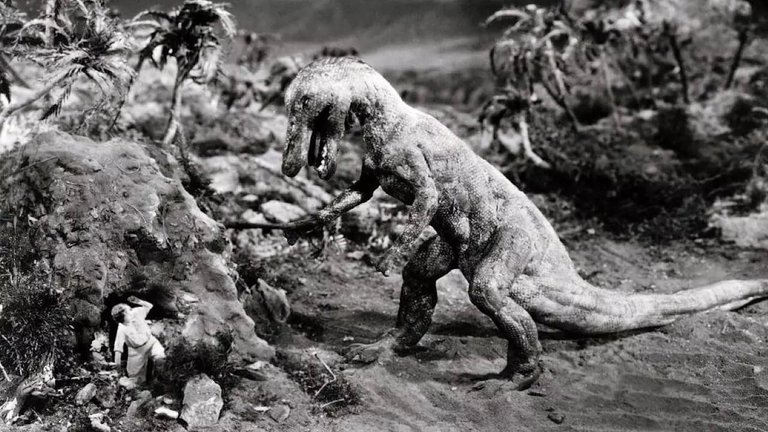Film Review: The Lost World (1925)

Dinosaurs are popular content for film and television today, and many mistakenly credit Steven Spielberg and his Jurassic Park as the catalyst for it. In reality, giant prehistoric beasts have aroused popular imagination for at least the past two centuries, inspiring many works of art and speculative fiction. This includes filmmakers, even in the beginnings of cinema, who saw the recreation of long-extinct animals as a worthy challenge, resulting in the development of new genres like animated film and special effects technology. The best-known, and arguably the most influential, of such works in the silent era is The Lost World, a 1925 science fiction adventure film directed by Harry O. Hoyt.
The film is based on the eponymous 1912 novel by Sir Arthur Conan Doyle, the first in the series about Professor Challenger. Doyle, who, although best known as the creator of Sherlock Holmes, claimed that he preferred Challenger as his favourite character, is briefly introduced to the audience in person at the beginning of the film. The plot begins in London, where young newspaper reporter Edward Malone (played by Lloyd Hughes) hears from his fiancée Gladys Hungerford (played by Alma Bennett) that she won’t marry him unless he does something extraordinary. An opportunity for that is provided by Professor Challenger (played by Wallace Beery), a brilliant but controversial and bad-tempered scientist who is often the object of ridicule by sceptics for his bold claims. The latest of these includes notes from a missing explorer, Maple White, who apparently discovered living dinosaurs on a remote isolated plateau within the Amazon basin. When Challenger starts an expedition to find White and prove his claims, he is joined by sceptical Professor Summerlee (played by Arthur Hoyt), big game hunter Sir John Roxton (played by Lewis Stone), White's daughter Paula (played by Bessie Love), and Malone, who is to cover the event for his newspaper. After a long journey, they arrive at the high plateau, which is completely inaccessible except for a location where a tree has been felled, serving as a bridge. They cross over, but a brontosaurus later arrives and removes the tree, trapping them. Challenger and the rest of the expedition must survive among the gigantic prehistoric fauna, which includes carnivorous allosaurus, while also finding a way home. As time goes by, Malone falls in love with Paula and, thinking that he will never return to Gladys and civilisation, wants to marry her with the help of Summerlee, who used to be a priest. A volcanic eruption and Roxton’s discovery of an alternative route will help Challenger not only to leave the plateau but also to bring a living specimen of brontosaurus to London and his sceptical peers.
Like many Hollywood silent-era classics, The Lost World is best appreciated for its historical importance rather than entertainment value. While it is directed and acted quite well by the standards of its period, a modern audience will soon recognise too much emphasis on cheap melodrama and misguided attempts at humour instead of action. Even more problematic, at least from today’s perspective, is the use of blackface for the character of the African American servant Zambo, played by Jules Cowles. However, these flaws can be forgiven if the film is viewed from the perspective of its time, especially in light of its simple but effective special effects and almost revolutionary use of stop-motion photography, which brought ancient creatures to life. The film looks even more impressive near the end when the captured brontosaurus sets itself free and creates mayhem on the streets of London. Those scenes were something quite extraordinary for the audience nearly a century ago. Willis O’Brien, the creator of the special effects, used his experiences from this production well for his even more impressive and groundbreaking work on King Kong eight years later.
The Lost World also entered history as the first film to be shown to airline passengers during a flight, which occurred on a Handley Page O-400, a converted WWI biplane bomber during an Imperial Airways flight between London and Paris in April 1925. The Lost World soon became irrelevant due to the discovery of sound, and for many years it was unavailable in its original form until being properly restored after the discovery of footage in Czech film archives. Despite that, it left a strong impression on future generations and was remade many times in film and television from 1960 until the mid-2000s.
RATING: 5/10 (++)
_
Blog in Croatian https://draxblog.com
Blog in English https://draxreview.wordpress.com/
InLeo blog https://inleo.io/@drax.leo
InLeo: https://inleo.io/signup?referral=drax.leo
Unstoppable Domains: https://unstoppabledomains.com/?ref=3fc23fc42c1b417
Hiveonboard: https://hiveonboard.com?ref=drax y
Bitcoin Lightning HIVE donations: https://v4v.app/v1/lnurlp/qrcode/drax
Rising Star game: https://www.risingstargame.com?referrer=drax
1Inch: https://1inch.exchange/#/r/0x83823d8CCB74F828148258BB4457642124b1328e
BTC donations: 1EWxiMiP6iiG9rger3NuUSd6HByaxQWafG
ETH donations: 0xB305F144323b99e6f8b1d66f5D7DE78B498C32A7
Posted using CineTV